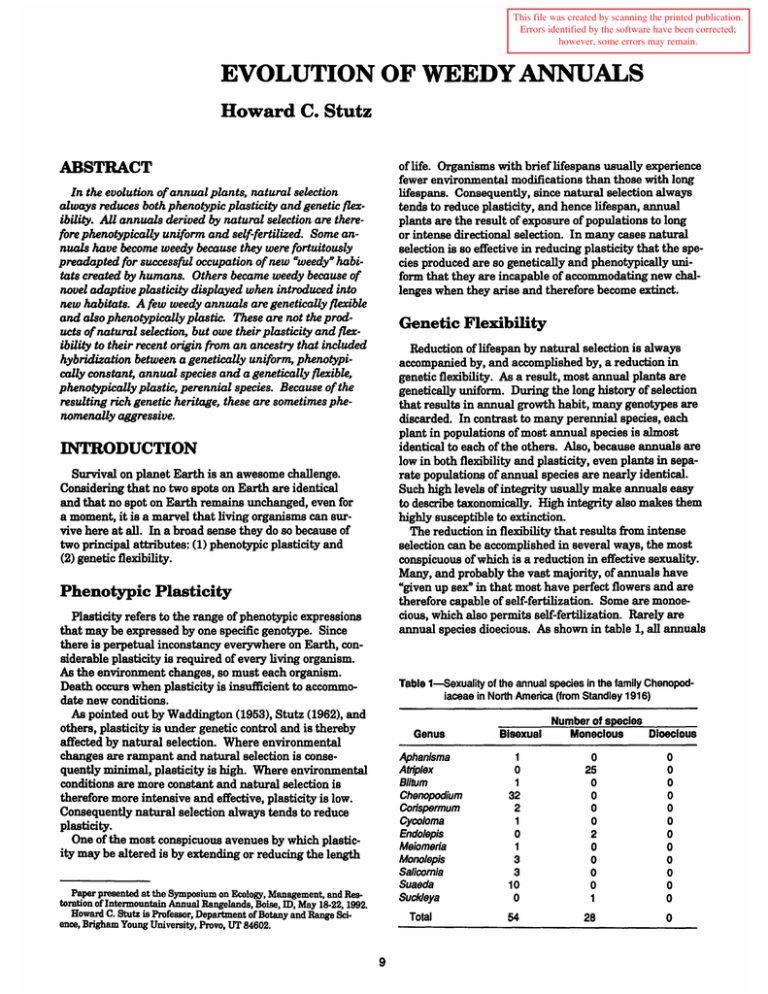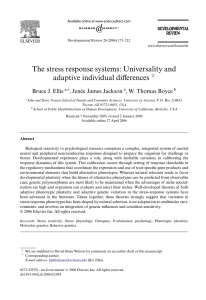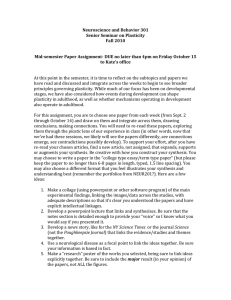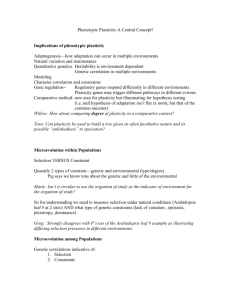EVOLUTION OF WEEDY ANNUALS Howard C. Stutz
advertisement

This file was created by scanning the printed publication. Errors identified by the software have been corrected; however, some errors may remain. EVOLUTION OF WEEDY ANNUALS Howard C. Stutz of life. Organisms with brief lifespans usually experience fewer environmental modifications than those with long lifespans. Consequently, since natural selection always tends to reduce plasticity, and hence lifespan, annual plants are the result of exposure of populations to long or intense directional selection. In many cases natural selection is so effective in reducing plasticity that the species produced are so genetically and phenotypically uniform that they are incapable of accommodating new challenges when they arise and therefore become extinct. ABSTRACT In the evolution of annual plants. natural selection always reduces both phenotypic plasticity and genetic flex· ibility. All annuals derived by natural selection are there· fore phenotypically uniform and self-fertilized. Some annuals have become weedy because they were fortuitously preadapted for successful occupation of new "weedy» habi· tats created by humans. Others became weedy because of novel adaptive plasticity displayed when introduced into new habitats. A few weedy annuals are genetically flexible and also phenotypically plastic. These are not the products of natural selection, but owe their plasticity and flexibility to their recent origin from an ancestry that included hybridization between a genetically uniform, phenotypi· cally constant, annual species and a genetically flexible. phenotypically plastic, perennial species. Because of the resulting rich genetic heritage. these are sometimes phe· nomenally aggressive. Genetic Flexibility Reduction of lifespan by natural selection is always accompanied by, and accomplished by, a reduction in genetic flexibility. As a result, most annual plants are genetically uniform. During the long history of selection that results in annual growth habit, many genotypes are discarded. In contrast to many perennial species, each plant in populations of most annual species is almost identical to each of the others. Also, because annuals are low in both flexibility and plasticity, even plants in separate populations of annual species are nearly identical. Such high levels of integrity usually make annuals easy to describe taxonomically. High integrity also makes them highly susceptible to extinction. The reduction in flexibility that results from intense selection can be accomplished in several ways, the most conspicuous of which is a reduction in effective sexuality. Many, and probably the vast majority, of annuals have "given up sex" in that most have perfect flowers and are therefore capable of self-fertilization. Some are monoecious, which also permits self-fertilization. Rarely are annual species dioecious. As shown in table 1, all annuals INTRODUCTION Survival on planet Earth is an awesome challenge. Considering that no two spots on Earth are identical and that no spot on Earth remains unchanged, even for a moment, it is a marvel that living organisms can survive here at all. In a broad sense they do so because of two principal attributes: (1) phenotypic plasticity and (2) genetic flexibility. Phenotypic Plasticity Plasticity refers to the range of phenotypic expressions that may be expressed by one specific genotype. Since there is perpetual inconstancy everywhere on Earth, considerable plasticity is required of every living organism. As the environment changes, so must each organism. Death occurs when plasticity is insufficient to accommodate new conditions. As pointed out by Waddington (1953), Stutz (1962), and others, plasticity is under genetic control and is thereby affected by natural selection. Where environmental changes are rampant and natural selection is consequently minimal, plasticity is high. Where environmental conditions are more constant and natural selection is therefore more intensive and effective, plasticity is low. Consequently natural selection always tends to reduce plasticity. One of the most conspicuous avenues by which plasticity may be altered is by extending or reducing the length Table 1-8exuality of the annual species in the family Chenopod· iaceae in North America (from Standley 1916) Genus Aphanlsma Atriplex 8/itum Chenopodium Corispermum Cyco/oma Endolepis Maiomarla Mono/apis Salicomia Suaeda Suckleya Paper presented at the Symposium on Ecology, Management, and Restoration of Intermountain Annual Rangelands, Boise, ID, May 18-22, 1992. Howard C. Stutz is Professor, Department of Botany and Range Sci· ence, Brigham Young University, Provo, UT 84602. Total 9 Bisexual Number of s~ecles Dloeclous Moneclous 1 0 1 32 2 1 0 1 3 3 10 0 0 25 0 0 0 0 2 0 0 0 0 1 0 0 0 0 0 0 0 0 0 0 0 0 54 28 0 in the family Chenopodiaceae are hermaphroditic or monoecious and therefore capable of self-fertilization. Also among 101 species of grasses catalogued by Stebbins (1950), 27 of the 30 annual species were self-fertile, three were facultatively cross-fertilized, and none were obligately cross-fertilized. The inbreeding that results from self-fertilization in annuals results in high levels of homozygosity. The principal source of variation to annuals is therefore from new mutations. Because of their short lifespan, new mutations can be more readily incorporated in annual species than in perennials, which is probably why the extinction rate in annuals is less than would otherwise be expected. Table 3-Lifespan and sexuality of Australian chenopods (from Wilso~ 1984) In contrast to annuals, perennial species are less subject to strong selection for phenotypic plasticity. During the long lifespan of perennials, selection vacillates from moment to moment, day to day, year to year, and therefore ~ermits the perpetuation of high levels of plasticity. The unpact on genetic flexibility that accompanies intense selection for low plasticity in annuals is therefore reduced in perennials. Genetic flexibility in perennials may therefore be altered by natural selection independently of alterations in plasticity. Consequently, although selection for low plasticity is always accompanied by a concomitant reduction in genetic flexibility, strong selection for reduced genetic flexibility does not necessarily carry with it a corresponding reduction in phenotypic plasticity. This is conspicuous in the modes of sexuality expressed in perennials as compared with those in annuals. As shown in tables 2 and 3, although all annual species of chenopods in both North America and Australia are either hermaphroditic or monoecious (and therefore have low genetic flexibility), perennials may be hermaphroditic monoecious, or dioecious. The higher frequency ofhe;maphroditic perennials in Australia, compared to North America, reflects the much longer history of chenopod evolution in Australia. During the millions of years of com.P~atively more stable geology in Australia, genetic fleXIbihty has been reduced in perennial chenopods by natural selection resulting in a high incidence of perfect 1 0 0 0 31 0 0 1 0 1 0 0 1 2 Total 3 0 1 0 0 0 0 0 6 31 0 2 0 16 85 13 10 0 8 Total 29 103 Weedy annuals are usually subject to novel environments not experienced by nonweedy annuals and therefore have some unique attributes. Because they usually occupy habitats that have been only recently disturbed by humans, their uniqueness is new. In some cases, annuals have become weedy because their genetic uniformity and low plasticity fortuitously favor some particular uniform, extant habitat created by human activity. Such appears to be the case with weeds such as "lambsquarter" (Chenopodium album) and "purslane" (Portulaca oleracea) that have found a favorable habitat in our gardens. They both show little genetic flexibility and low phenotypic plasticity. Their success as weedy annuals appears, therefore, to result mostly from a fortuitous abundance of a uniform habitat to which they happened to be suitably adapted. Some weedy annuals appear to have become successful because of residual phenotypic plasticity that became Number of species Moneclous Dloeclous Allenrolfia Atripfex Cerato/des Grayia Kochis Sarcobatus Suaeda Zuckia Annual Perennial Number of species Moneclous Dloeclous WEEDYVS. NONWEEDY ANNUALS Table 2-5exuality of the perennial species of the family Chenopodiaceae in North America (from Standley 1916) Bisexual Bisexual flowers. In contrast, because of the younger, less stable, geology of North America, genetic uniformity bas been less severely selected, and most perennials are consequently dioecious and therefore rich in genetic flexibility. Phenotypic plasticity and genetic flexibility of plants are thus reflections of the stability or instability of the landscapes they occupy. Tumultuous environmental changes translate to low predictability, and hence relaxed selection, the consequence of which is high plasticity and high flexibility. Repeated, predictable conditions such as those that occur diurnally, seasonally, or after a summer rainstorm, or in a plowed field, equate to effective selection, which always reduces both plasticity and flexibility. As shown in table 4, high flexibility and high plasticity ~acterize perennials that occupy fluctuating, unpredictable sites. They are typically dioecious. Monoecious or bisexual perennials that occupy rythmically predictable, but restricted, sites have sufficient plasticity to permit their long lifespan but, because of inbreeding, are low in genetic flexibility. Highly predictable, narrow ecological sites are occupied by self-fertilized annuals that are low in both flexibility and plasticity. There are no dioecious annuals, because they would require low plasticity and high flexibility, an impossible situation because selection for low plasticity is always accompanied by selection for low flexibility. Exceptions are in cases like cereal rye that have a cross-fertilized perennial in their recent ancestry from which they attained both high flexibility and high plasticity. ANNUALS VS. PERENNIALS Genus Lifespan 10 Tabla 4-lntaractions of genetic flexibility and phenotypic plasticity in relation to lifespans and sexual strategies in chenopods Flexibility Sexual strategy Plasticity LHespan High Dioecious High Perennial High Dioecious Low Annual Low Monoecious or bisexual High Low Monoceclous or bisexual Low Ecological niche Examples (genera) Wide, unpredictable Atriplex Perennial Restricted. rhythmically predictable Cerato/des Sarcobatus Maireana Sclero/aena Annual Narrow, highly predictable Chenopodium Atriplex species, one of which is cereal rye (Secale cereale). The annual habit, rich genetic flexibility, and extensive phenotypic plasticity of cereal rye preadapted it for its rapid invasion of disturbed habitats both in the Middle East and in western North America. released in their new environments, without significant increase in genetic flexibility. This appears to be true of Bromus tectorum, 8alsola australis, Halogeton glomerata, and several other species that became weedy upon introduction into new environments. Other weedy annuals owe their success to t:Jleir evolutionary ancestry. This is true of the annual species Secale cereale (cultivated rye), which only recently became weedy in the Western United States. In contrast to most annuals, 8ecale cereale is cross-fertilized and is therefore rich in genetic flexibility. It also differs from most annuals in being phenotypically highly plastic. S. cereale obtained these striking attributes from its ancestors, not from relaxed selection. One ancestor of 8ecale cereale (Secale silvestre) is a highly uniform, self-fertilized annual species. As with most annuals, it is extremely site specific, growing only in the sandy steppes of southwestern Russia and southeastern Europe. It is low in both genetic flexibility and phenotypic plasticity. The other ancestor of cultivated rye, 8. montanum, is a cross-fertilized, highly variable, perennial species. It has a widespread distribution throughout the Mediterranean and Middle East countries from Spain and Morocco to Iran and Iraq. It is rich in both genetic flexibility and phenotypic plasticity. Hybrids are common between S. montanum and S. silvestre (and 8. vavilovii, a derivative of 8. silvestre) in northeastem Turkey and northwestern Iran. Hybrid swarms resulting from these hybrids have produced several new ACKNOWLEDGMENTS Gratitude is expressed to BHP-Utah International Inc. for extensive support and encouragement of research from which many of these concepts were generated. REFERENCES Standley, P. C. 1916. Chenopodiaceae. North American Flora. 2: 1-93. Stebbins, G. L. 1950. Variation and evolution in plants. New York: Columbia University Press. 643 p. Stutz, H. C. 1962. Within penetrance, between penetrance and expressivity of the elymoides mutant in rye. Journal of Heredity. 53: 66-71. Stutz, H. C. 1972. On the origin of cultivated rye. AmericanJournal ofBotany. 59:59-70. Waddington, C. H. 1953. Genetic assimilation of an acquired character. Evolution. 7: 118-126. Wilson, P. G. 1984. Chenopodiaceae. In: Flora of Australia. vol. 4: 81-854. 11







